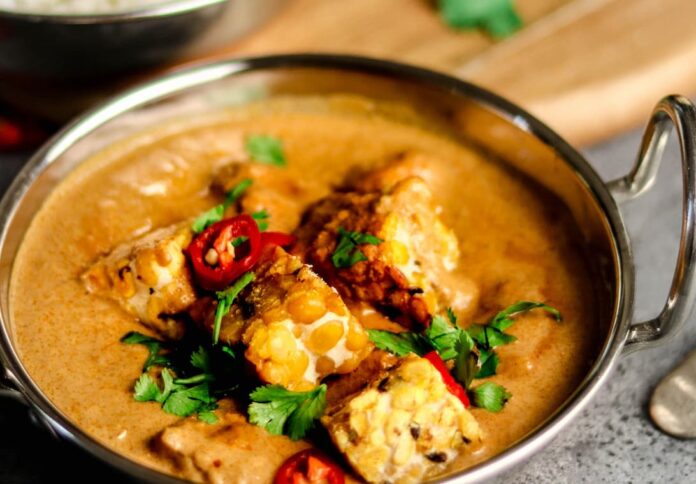A hearty bowl of curry paste is practically the epitome of “comfort food,” as anyone who has ever eaten one would attest. Curries, typically served over fluffy rice, have a gravy-like consistency that may fill you up for hours on end. Curry is a comforting dish for the soul. Okay, then tell me what curry is, which varieties are most popular, and how to prepare it at home. Explore all of this and more in our comprehensive guide to curry by continuing to read!
What is Curry Paste?
The most traditional cuisine is the Rice Meal, which is prepared using different vegetables, herbs, and spices. Popular ingredients such as turmeric, pepper, ginger, garlic, onions, tomatoes, pepper, coriander, and curry paste are some of the seasonings used. Normally, curries consist of protein like chicken, lamb, chunky-style veggies, or grounded veggies like beans or chickpeas.
If you ever need any more ingredients, you can just look up curry paste online. Curry comes in a wide variety of forms, all derived from a few fundamental components. After cooking the onion, ginger, and garlic, you add tons of spices and combine everything with a liquid foundation. Curry cooking is more about technique than it is about following a recipe because the kind of spices you use and enjoy will determine the final flavour.
What Do You Put in a Curry?
Primarily a British invention, curry powder is used in homes to simplify the process of seasoning curries once the British returned home. Turmeric, a stunning yellow spice from the ginger family, is typically the backbone for this mixture, which also includes a variety of other spices, including dried basil, mustard seeds, mace, poppy seeds, sesame seeds, saffron, or cinnamon, as well as cloves, cardamom, ginger, nutmeg, fennel, and caraway.
How Do You Cook a Spicy Curry?
Since peppers—fresh, dried, ground into a paste, or powdered—are the source of curry’s flavour, spiking your curry with more chilly peppers is a simple method to intensify its heat. The simplest approach to add heat when using store-bought curry pastes or spices is to add fresh chills such as jalapeño, serrano, habanero, or Scotch bonnet. You can make a delicious curry by following these steps.
1. Let the Meat Brown
Your curry will taste much better once the meat has been seared, but to achieve a firm sear and avoid steaming, you’ll need to add the meat in stages. Vegetable oil is heated in a big skillet over medium-high heat. In around five minutes, add the meat in batches and brown it on all sides. Cooking it through is not necessary because there will be plenty of time to do it later! After that, take it out to a platter and leave it there while you brown the remaining meat.
Step 2: Let the Onions Begin to Sweat
Once the beef is browned all the way through, add the chopped onion to the skillet and cook over medium-high heat for approximately five minutes or until the onion starts to caramelize on the edges. You should have enough oil left in the pan, but if not, feel free to add more.
Step 3: Bloom the Spices
The fun part is about to start: add the spices, ginger, and garlic. For a curry to be successful, the spices must be allowed to bloom since this releases important flavour compounds. This takes only a few minutes; you don’t want the garlic to turn brown and bitter. When the aroma in the room becomes utterly enticing, you know it’s finished!
.Step 4: Let the Curry Simmer
Add the tomatoes and broth. Simmer the mixture for around five minutes to allow the flavours to mingle. Reduce the heat to low and return the browned meat, if used, to the boiling sauce. When the meat is soft and well cooked, cover the skillet and cook for five to ten minutes.
Step 5: Have Fun
When the curry is thick and sauce-like, it’s ready to start eating! Spoon the sauce over a rice platter. Top with freshly chopped cilantro to bring out the flavours. If your curry looks bland, add a bit more salt or whisk in some acidic ingredients, such as vinegar or lemon juice.
Curry Storage Tip
Proceed by keeping leftovers in a sealed refrigerator container. Food expiration date depends on its ingredients. If meat is likely to be involved, freeze the remaining portion and refrigerate the remaining food only for a maximum of three days of storage. This is very expensive. If you are an ardent vegan curry fan, you can stay within your calorie plan; vegan curries generally contain fewer calories than their meatier counterparts, which can be bought and stored in the fridge for around three to four days without getting spoiled.
To keep your curry registered for up to a month, you can also place the curry in a plastic freezer bag or storage box. Remember to date-mark your container because the longer your curry sits in there, the less flavour and texture it will have!
Final Thought
One classic food from tradition is curry. Even though some people find it tough to create, if you follow the above instructions, it’s pretty easy. I hope you enjoy this easy chicken curry, although many more varieties use different flavours and herbs.
Read More On: magmystery.com



